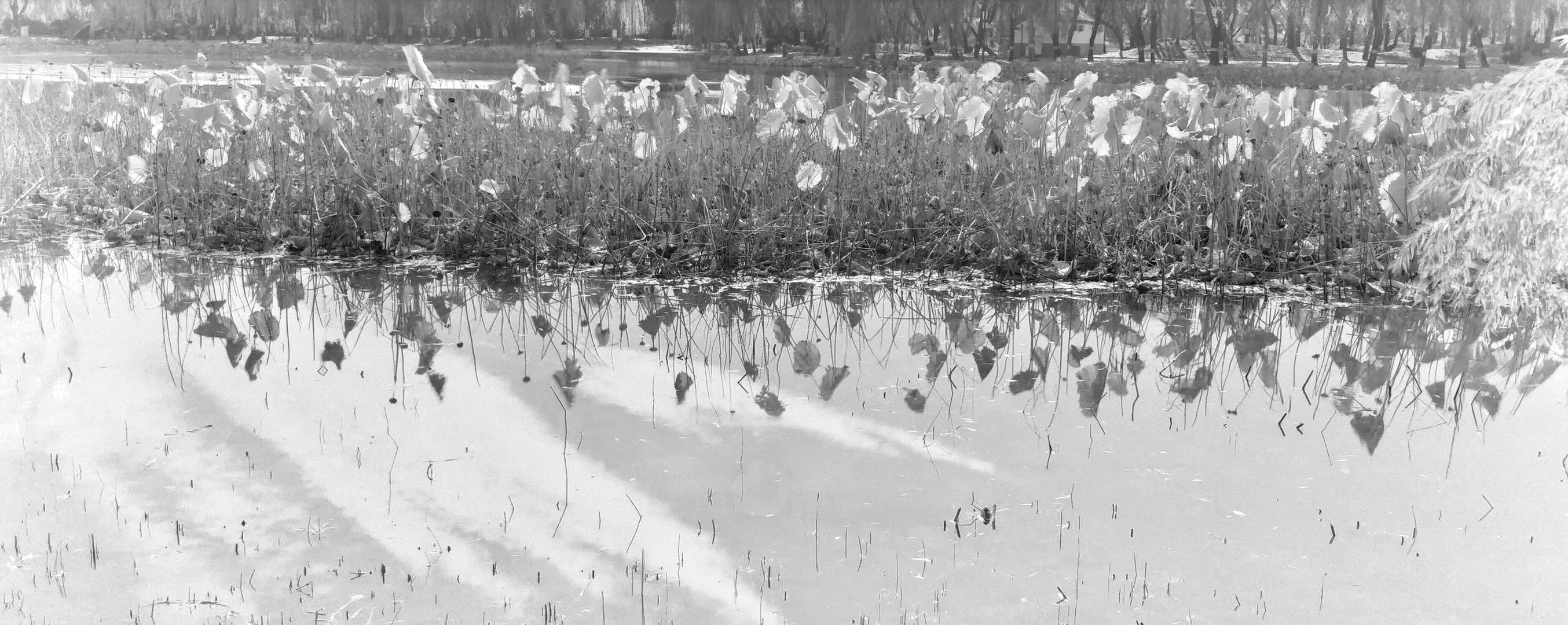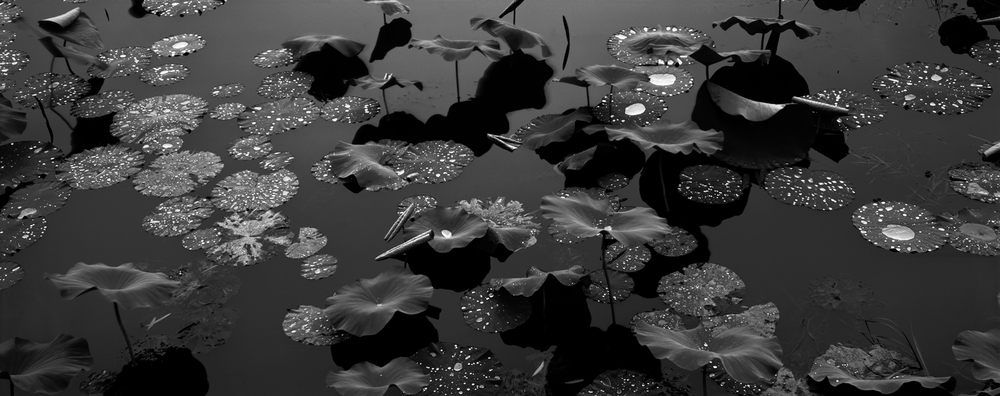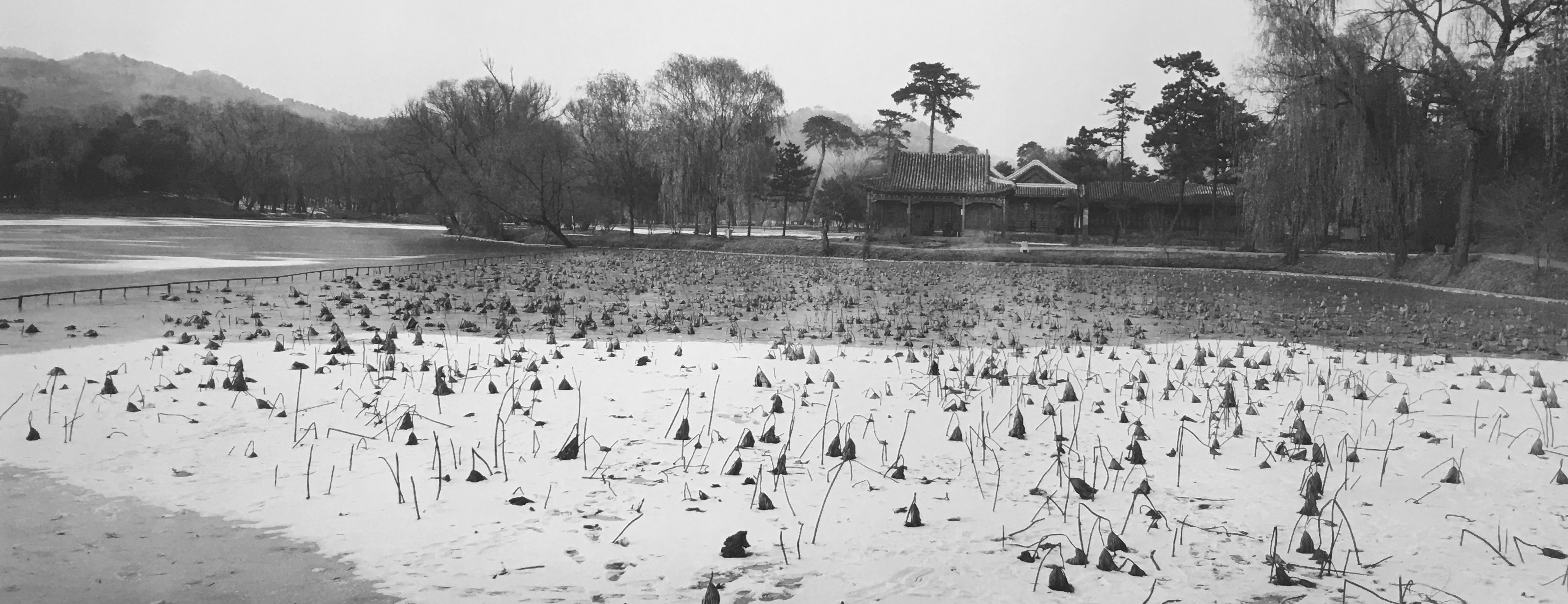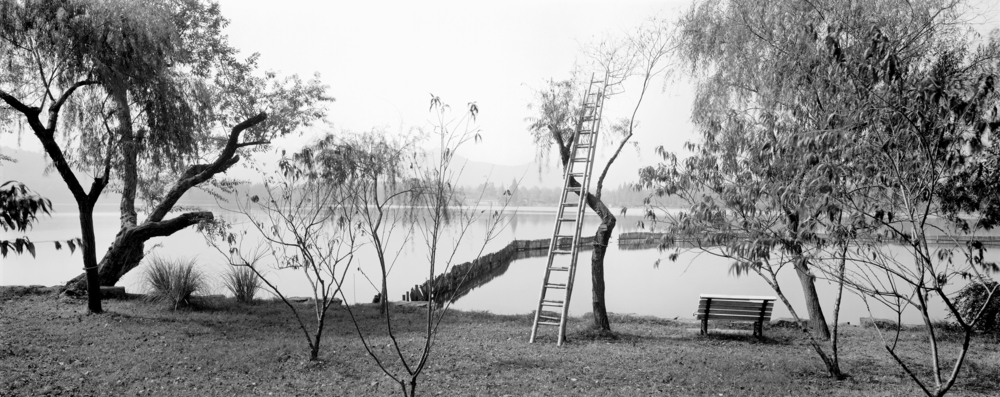The new masthead of China Heritage is a photograph made by Lois Conner in the Garden of Perfect Brightness 圓明園, northwest Beijing:

The lakeside scene takes its name, ‘Pine Breeze, Wisteria Moon’ 松風蘿月 — ‘the wind scented by pine trees, the moon seen through a wisteria trellis’ — from a line in a poem by the Qianlong Emperor composed in 1762:
Folded hills, serene waters convey a heavenly truth
Wisteria moon, pine winds invite contemplation
屏山鏡水皆真縡,
蘿月松風合靜觀。
‘Pine Breeze, Wisteria Moon’, where a pavilion inscribed with Qianlong’s poem once stood, marks a unique location in the sprawling gardens. It is next to an intersection of the original Garden of Perfect Brightness 圓明園, to the west, the Garden of Extended Spring 長春園 to the north and the Garden of Brocade Spring 綺春園 to the south. Constructed and extended over a period of nearly 150 years, the three garden-palaces are collectively known as the ‘Garden of Perfect Brightness’. The masthead also reflects the theme of the 2019 China Heritage Annual, which is Translatio Imperii Sinici — the skein of empire in modern China.
My thanks to Callum Smith, the designer of this site, for his work on new masthead, Lois Conner for her ongoing and generous support and Gerald Szeto 司徒佐 for allowing us to use his March 2019 photograph of Lois.
— Geremie R. Barmé
Editor, China Heritage
13 March 2019
***

Over the years, Lois Conner has repeatedly returned to the lotuses that still fill the lakes of Beijing in the summer months and augur the changing seasons of the capital. She thinks of them as her muse, as well as being deeply emblematic of the former imperial city and a more ephemeral, if recurring, aspect of its traditional aesthetic.

Chinese art has long treated the lotus as symbolic of transient worldly glory: resplendent one day and shorn of splendor the next. The flower has varied associations — with lithe sensuality, for example, as well as with others that no longer seem that sublime: ‘golden lotuses’ 金蓮 and ‘hooked lotuses’ 鉤蓮 are poetic terms for the disfigured stumps produced by the binding of girls’ feet in dynastic times.
Perhaps the dominant association of the aquatic nelumbo nucifera is with the Buddha. In India, where Buddhism originated, the lotus was an early symbol of sunlike power and vitality. The chakras, those whorling nodes of potential and awakening power that run along the spine of the human body, take the pictorial form of dormant or fully blossoming lotus flowers. In the heart of the blossom grows awareness, perfection. As a newborn child, Siddhartha Gautama, later the Buddha, was said to have taken seven steps on the earth from which lotuses sprang; in artistic representations, his footprint is often adorned with a lotus pattern. He, as well as myriad bodhisattvas, are most often represented seated upon or within the sacred flower in the folded-legged ‘lotus posture’. The eleventh-century writer Zhou Dunyi 周敦頤, famed for his ‘Essay on Loving Lotuses’ 愛蓮說, quotes a Buddhist line about the leaves and flowers of the aquatic plant: ‘They emerge from the mud yet remain untainted’ 出淤泥而不染. Tibetan Buddhists are constantly mindful of the significance of the lotus as they repeat the Sanskrit mantra-prayer Auṃ maṇi padme hūṃ ཨོཾ་མ་ཎི་པདྨེ་ཧཱུྃ, ‘Hail the jewel in the lotus!’ The botanist Peter Valder has written of the lotus in his magisterial work The Garden Plants of China:
The fact that seed pods, flowers, and buds are present at the same time denotes the three stages of existence — past, present, and future. The many seeds in each head suggest abundant progeny and, because its rhizomes are firmly rooted in the mud and its flowers and leaves are numerous, it is a symbol of steadfastness and prosperity in the family. And the pronunciation of the Chinese names for the plant, Lián 蓮 and Hé 荷, is the same as it is for other characters denoting continuity and peace, respectively.

In the early spring, the first leaves of the lotus pierce the surface of lakes and ponds, unfurling and floating as if not tethered. Through the summer the leaves lift above the water, growing to their full expanse and swaying, blowsy in wafts of warm air, quivering on thin stalks. By autumn the limpid sticks of the now-decayed stems, heavy with the umbrella of shriveled leaves, collapse, crumbling into calligraphic forms. Finally, the dried-out skeletons of the plants lie brittle and crushed on the water’s surface, metamorphosing into a bas-relief in mud or magnified and preserved under an icy crust during the winter months. The life cycle of the lotus provides Lois Conner with inspiration, appearing vibrant and luscious at the height of the summer season and in its autumnal, dying mien at the Garden of Perfect Brightness.

Originally, Lois Conner made her spare, calligraphic lotus studies in the southern lake city of Hangzhou, whose poetry and landscapes, both natural and built, inspired many of the imperial gardens and villas of Beijing and beyond. The seasonal contrast of the north provided the artist with another dimension of the lotus. At the Imperial Summer Lodge 避暑山莊 in Chengde, for example, she found the Kiosk for Appreciating Lotuses 觀蓮亭, a scene with a pavilion and lotus-filled lake inspired by Zhou Dunyi’s essay mentioned above. Here the lotus plant, literary tradition, and political power come together: it is said that while in residence here before the autumn hunt, the Kangxi emperor (r. 1662-1722) asked the brightest of his grandchildren, Hongli 弘曆, whether he could recite Zhou’s essay. The young boy did so with aplomb, greatly pleasing both the grandfather and his father, the future Yongzheng emperor (r. 1723-1735) and creator of the Garden of Perfect Brightness. The young boy, Hongli, would himself eventually inherit the throne and reign for nearly sixty years — as the Qianlong emperor.
— G.R. Barmé, from Beijing: Contemporary and Imperial
Princeton Architectural Press, 2014, pp.155-156

Lois Conner and Geremie R. Barmé collaborations
- The Garden of Perfect Brightness, a life in ruins, 1996
- China: The Photographs of Lois Conner, New York: Callaway, 2000 (essay)
- Lois Conner exhibition, Sherman Galleries, Sydney, 2001, catalogue
- Twirling the Lotus: Photographs from Tibet and China, 2007 (essay)
- Life in a Box, 2010 (essay)
- Beijing Building, London: Rossi & Rossi, 2011 (essay)
- Works by Lois Conner featured in the Australian Research Council Federation Fellowship Office, later the offices and corridor occupied by the nascent Australian Centre on China in the World (CIW), Coombs Building, Australian National University, 2006-2014
- China Heritage Quarterly: annual masthead images, 2009-2012
- China Heritage Quarterly: photographic essays in issues focussed on The Garden of Perfect Brightness; Beijing; Shanghai; and, West Lake
- Lois Conner’s review of Felice Beato — a Photographer on the Eastern Road for China Heritage Quarterly
- China Story Yearbook 2012: Red Rising, Red Eclipse, cover image
- The China Story Gallery, 2012-2014
- Beijing, contemporary and imperial, Princeton Architectural Press, 2014
- ‘Beijing, an unfolding landscape’, Inaugural CIW Exhibition, exhibition and catalogue, May 2014
- Works by Lois Conner in the Australian Centre on China in the World (CIW), 2014-2015
- A painting by Zhang Peili 張培力 donated to the Australian Centre on China in the World on 26 August 2016 by Lois Conner to celebrate the creation of the Centre
- China Heritage, masthead, December 2016 to March 2019
- A New York Eye on The Rapa, China Heritage
- China Heritage Annual 2017: Nanking, masthead, 2017
- 顛倒 Downside Up, exhibition title and essay, March-September 2017
- Exhibition at le Quartier Français, Featherston Booktown, South Wairarapa, 13-14 May 2017
- Twenty Views of Fragrant Harbour, China Heritage, 8 July 2017
- ༄༅། ཞོ་སྟོན། Yoghurt Festival, China Heritage, 10 August 2017
- The Affinities of Art 藝海因緣, China Heritage, 26 August 2017
- Exhibition at le Quartier Français for the Wairarapa Academy for New Sinology, Featherson, February 2018
- A Long View 路漫漫 上下求索, Shanghai Center of Photography, exhibition title, March 2018
- A New Sinology Reader, masthead, March 2019
- China Heritage, masthead, March 2019-

